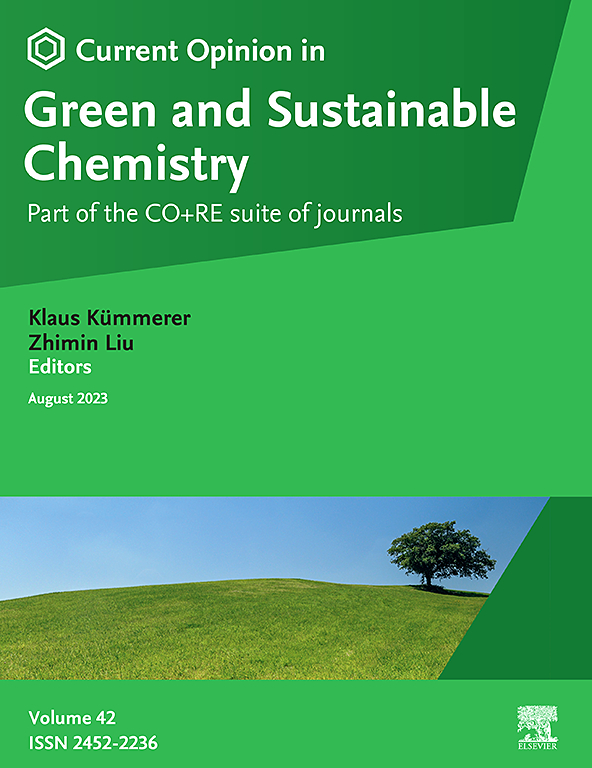Emerging trend in porous carbon as catalysts support for biofuel production
IF 9.4
2区 化学
Q1 CHEMISTRY, MULTIDISCIPLINARY
Current Opinion in Green and Sustainable Chemistry
Pub Date : 2025-01-30
DOI:10.1016/j.cogsc.2025.101005
引用次数: 0
Abstract
The depletion of fossil fuels and increasing demand on renewable biofuels, particularly enhancing energy security through sustainable biomass sources in catalytic activities. Heterogeneous catalysts are pivotal in advancing sustainable biofuel production by enhancing yield and reducing costs. Metal oxides are widely used as catalysts due to their active sites, high thermal and chemical stability. However, unsupported metal oxides often result in low yield, requiring large amounts of catalyst and long reaction times to achieve high biofuel production. Thus, it has attracted attention toward sustainable porous carbon supports to resolve the shortcomings. The porous carbon is gaining prominence as a sustainable catalyst support due to its renewability, cost-effectiveness, abundance, versatile surface functionalities, tuneable porosity, high surface area, and improved accessibility for reactants. This review explores the roles of sustainable porous carbons, including biochar, activated carbon, graphene-based materials, and carbon nitride, showcasing their distinctive properties in specific catalytic reactions. It encompasses the characteristics of porous carbon supports, such as hierarchical micro-mesoporous structure, pore distribution, pore size, specific surface area, interaction with active metals, in assisting the catalytic active sites for macromolecules cracking, aromatization, deoxygenation, and so forth. Despite the promising advancements, several challenges remain, including the need for cost-effective synthesis methods and long-term stability of catalysts. Ultimately, maximizing the potential of porous carbon as catalysts support is essential for advancing research in biofuel production.

多孔碳作为生物燃料生产催化剂的新兴趋势
化石燃料的枯竭和对可再生生物燃料的需求不断增加,特别是通过催化活动中的可持续生物质资源加强能源安全。多相催化剂通过提高产量和降低成本来推进可持续生物燃料生产是至关重要的。金属氧化物因其具有较高的热稳定性和化学稳定性而被广泛用作催化剂。然而,无负载的金属氧化物通常导致低产量,需要大量的催化剂和较长的反应时间才能实现高生物燃料产量。因此,人们开始关注可持续多孔碳支架,以解决其不足之处。多孔碳由于其可再生、成本效益、丰富度、多种表面功能、可调节孔隙度、高表面积和改善反应物的可及性而成为可持续催化剂载体。本文综述了可持续多孔碳的作用,包括生物炭、活性炭、石墨烯基材料和氮化碳,展示了它们在特定催化反应中的独特性能。它包括多孔碳载体的特征,如层次微介孔结构、孔分布、孔径、比表面积、与活性金属的相互作用,在协助大分子裂解、芳构化、脱氧等催化活性位点的作用等。尽管取得了有希望的进展,但仍然存在一些挑战,包括需要具有成本效益的合成方法和催化剂的长期稳定性。最终,最大化多孔碳作为催化剂支持的潜力对于推进生物燃料生产的研究至关重要。
本文章由计算机程序翻译,如有差异,请以英文原文为准。
求助全文
约1分钟内获得全文
求助全文
来源期刊

Current Opinion in Green and Sustainable Chemistry
Chemical Engineering-Catalysis
CiteScore
16.00
自引率
2.20%
发文量
140
审稿时长
103 days
期刊介绍:
The Current Opinion journals address the challenge specialists face in keeping up with the expanding information in their fields. In Current Opinion in Green and Sustainable Chemistry, experts present views on recent advances in a clear and readable form. The journal also provides evaluations of the most noteworthy papers, annotated by experts, from the extensive pool of original publications in Green and Sustainable Chemistry.
 求助内容:
求助内容: 应助结果提醒方式:
应助结果提醒方式:


